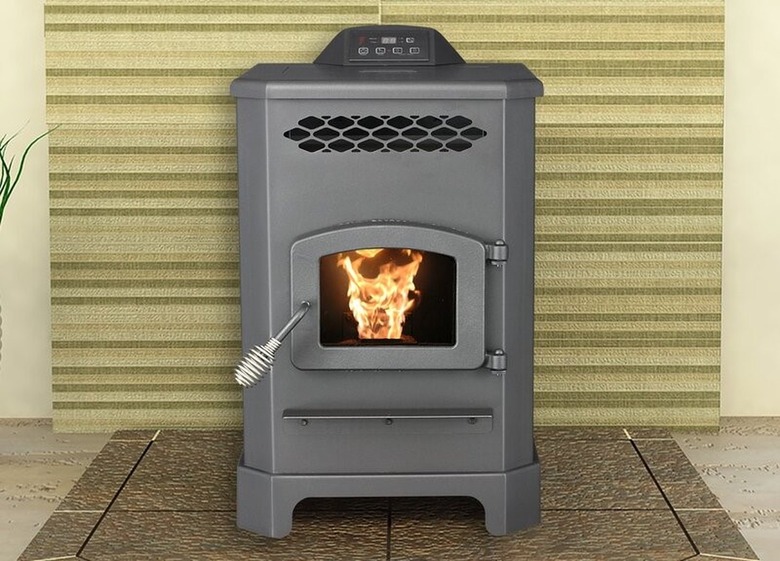Basement Vent Options For A Pellet Stove
We may receive a commission on purchases made from links.
Subterranean spaces, like basements, tend to stay colder than the rest of the house. In such locations, it may make sense to use a pellet stove. Fueled by pellets made from a variety of recycled materials, including compressed sawdust, pellet stoves burn hotter than fireplaces and wood-burning stoves. They also result in healthier air since they produce very little smoke and ash.
Pellet Stove Venting
Pellet Stove Venting
If you decide to install a pellet stove in your basement, proper exhaust venting and fresh-air intake vents are essential. Proper venting is important for the health and safety of the home's occupants. Improper venting can lead to smoke and ash buildup in the home that can aggravate sensitive people with breathing disorders. Additionally, improper venting could also lead to the buildup of carbon monoxide, which can be deadly to people and pets.
Proper venting clearance requirements include 12 to 48 inches from a window or door. Additionally, there must be a minimum of 18 inches from a ventilated soffit and 12 inches from an unventilated one. Clearance to an inside corner is 12 inches and to an outside corner is 18 inches. A vent must not be placed within 3 feet of a gas meter.
Basement stove venting requires a fresh-air intake and a flue for exhausting waste air from the home. The pellet stove may use the air within a room for fresh-air intake or from the outside via a direct vent through an external wall. Waste air must be vented to the outside using a flue. A variety of exhaust piping options exist, including type L and direct vent. Which type you use will depend on the type of venting system. The system will also require a wall thimble for attaching the piping to an outer wall or the ceiling and a vent cap on the exterior.
Stainless steel inner piping with galvanized steel outer piping is the correct material for piping out exhaust from a pellet stove. Certain materials are not appropriate for venting a pellet stove. These include dryer vent hoses, gas appliance vent hoses, and PVC piping. Exhaust on the pellet stove is pressurized, so joints within the pipe must be sealed with silicone or have gasketed connections.
Pellet Stove Basement Venting Options
Pellet Stove Basement Venting Options
Pellet stove exhaust must be vented outside of the home for safety reasons. Various options exist for pellet stove venting. In general, venting can be attached to other venting in the home, or you can vent directly outdoors. Vent options include venting vertically through the roof or horizontally through a sidewall. If you already have a wood-burning stove in the basement, you can vent through the wood-burning stove's existing chimney.
Internal Wall Installation
Internal
Wall Installation
The first option is to install a pellet stove on an internal wall and run the flue directly up through the home's roof. This requires routing the vent pipe in a similar fashion to how a wood-burning stove vent pipe is routed. You attach an adapter to the pellet stove and route the vent system up through the ceiling and then the roof. This requires a ceiling support box, a flashing kit, and an attic insulation shield.
The internal wall installation method is ideal when the pellet stove must be placed in an area of the basement that is located away from external walls. The downside is that you will need to make cuts in the ceiling of the basement, the upper floor, and the roof.
External Wall Installation
External
Wall Installation
The second option is to install the pellet stove against an external wall of your house. A flue is then installed horizontally through the external wall and then run vertically up the side of the exterior wall of your home.
This method, which uses an L-vent pipe, only requires cutting into the side of the building. However, the downside is that the piping must have a 3- to 4-foot vertical rise to ensure that the smoke will rise up and out of the home in a natural draft if the power happens to go out, and the pellet stove's exhaust fan isn't operational. This takes extra work and planning during installation.
Installation Within an Existing Fireplace
Installation Within an Existing Fireplace
The third option is to install the pellet stove within an existing masonry fireplace and use the chimney for venting. This option can work well provided that the fireplace is large enough to accommodate the pellet stove. The downside of this method is that not all pellet stoves will fit in existing fireplace. You must also have a flue liner insert installed within the chimney for the area between the stove and the top of the chimney so that the exhaust travels up and out.
